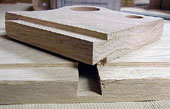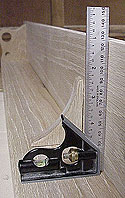This is a Veteran Owned site
Oak Shelf/Curtain RodBy Tom Hintz During the renovation of our living & dining rooms, my wife Beth, and I went to lunch at a local establishment that was decorated with wood shelves on the walls. Beth liked the look of the shelves so I seized on the moment and secured the official OK for a new project. After a little discussion, (Beth telling me how they needed to be) we came up with our version of the shelves that incorporated curtain rods below the shelf surface. Eventually I would like to have the entire interior of our home trimmed in oak and figured I should start with these shelves. Aside from the looks, this project lends itself to the strength and stability of solid oak. After measuring the two windows above which the shelves would reside, we bought a sufficient quantity of ¾-inch red oak and headed for the shop. My lumber calculating skills are improving. This project was completed from the original lumber purchased; with less than a foot left over. And, no emergency lumber runs necessary. I soon discovered that curtain rods must be located at a specific height to prevent them from contacting the floor. This is obviously a "woman thing." Too many guys would make the shelves how they wanted and if the bottom of the curtains were bunched on the floor we would simply fold the bottom edge up to stop that; and secure the excess curtain with duct tape. The more stylish guys would put the fold and duct tape on the back of the curtains.
As I was nearing completion of the design of the brackets, which would support the curtain rods, I was informed there is a header built into the curtains that means additional clearance is required between the curtain rod and the bottom of the shelf. A rethinking of the bracket design resolved that clash and I was ready to begin cutting wood. One shelf / curtain rod unit was to be 7 feet long, the other 5 feet long. Both have a 5 ½-inch-wide shelf with a 3 ½-inch-wide skirt below it, against the wall. I cut a ¾-inch-wide, 1/8-inch-deep dado along the bottom of the back edge of the shelf to help locate the skirt. Each unit has a bracket at either end with accommodations for the 1 ¼-inch diameter main curtain rod and a 5/8-inch secondary rod for the sheer panels that hang closest to the window. The primary curtain rod passes through the end brackets but the sheer rod is spring-loaded so its holes are only ½-inch deep. Both were drilled with forstner bits. I wanted the brackets to be strong, perfectly aligned, and for everything to stay put over the years. I thought about making stop dados but decided to try dovetails instead. I cut the 5/8-inch female dovetails in the bottom of the shelf using my new Porter Cable router and a clamp-on guide. The corresponding male dovetails on the brackets were cut at the router table. I actually found this process much easier than anticipated. I made sure to start out oversize on the male dovetails, and then sneaked up on a tap-in tight fit. The back edges of the brackets are cut flat and secured to the skirt with glue and a single screw in each one. The center brackets are not involved in supporting the curtain rods and probably are not necessary, but I think they give the piece balance, provide more stability for the shelf, plus they look cool. I used one center bracket on the five-foot shelf, and two on the seven-foot version. All center brackets are curved so they do not interfere with the curtains or that two-inch header I learned about earlier. I made the primary curtain rod from 1 ¼-inch poplar round stock. Beth picked out a set of finials, which were attached with studs to the ends of the poplar stock that protrudes outside the end brackets enough to provide ¼-inch clearance when assembled. After final sanding, I turned the shelves over to Beth, the official finishing department. She applied Olympic Colonial Oak oil based gel stain, followed by three coats of Olympic water based satin polyurethane. We measured out three mounting points for each shelf, installed screws in the walls and mirror hangars on the backs of the shelves along with felt bumpers to prevent marking the walls or rattles. Beth loves the finished product; they look great, and were fun to build. In addition, I learned how to make dovetail joints outside the corner of a drawer. Sorry, we do not build this project for sale or have plans for it. Do you have a comment about this page? - Email Me! |
All written, photographic and drawn materials are property of and copyright by NewWoodworker.com LLC 2000-2019. Materials may not be used in any way without the written permission of the owner.




